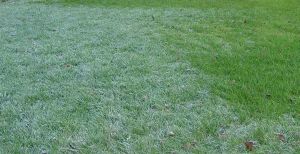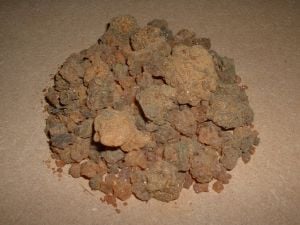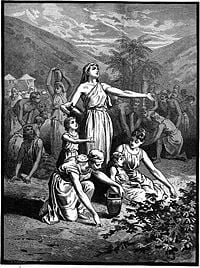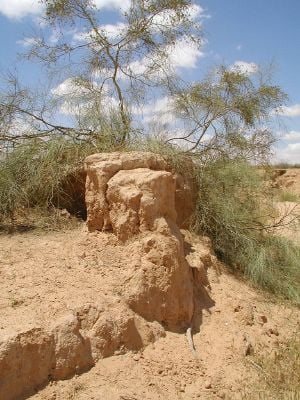Difference between revisions of "Manna" - New World Encyclopedia
m (→See also) |
|||
| Line 1: | Line 1: | ||
{{Started}}{{Contracted}} | {{Started}}{{Contracted}} | ||
| + | [[Image:Manna-from-heaven.jpg|thumb|300px|Moses with the Israelites collecting manna as it falls from heaven]] | ||
| + | '''Manna''' is the name of the [[food]] [[miracle|miraculously]] produced for the Israelites in the desert in the book of [[Exodus]]. According to the biblical story, the term originated from the mysterious nature of the food, as the Israelites asked ''"Man hu"''—translated as "What is it?" or "Is this manna?" Falling like hoarfrost to the ground and brownish in color, Manna was gathered each morning by the Israelites, except on the sabbath. It is described as tasting either like bread, oil, or (in the cae of infants) milk. Manna became a source of irritation for some of the Israelites, however, and they complained bitterly, wishing they return to Egypt where the diet was more varied. | ||
| − | + | Manna reportedly sustained the the Israelites through the 40 years in the wilderness and ceased to appear when the Israelites first harvested their crops in their new homeland. Various modern opinions exist about various natural substances that may have been the source of the legend of manna from heaven. By extension "manna" has also been used to refer to any divine or spiritual nourishment. | |
==Biblical Manna== | ==Biblical Manna== | ||
| − | + | [[Image:Frostw.jpg|right|thumb|Hoarfrost on [[grass]] lawn]] | |
| + | [[Image:Myrrh.JPG|thumb|Myrrh, which is related to the biblical bdellium—manna was probably of this color.]] | ||
According to the Bible, the mysterious substance which was provided miraculously by God to the Hebrews during their 40 years in the desert descended by night like hoarfrost in the form of [[coriander|coriander seed]] of the color of [[bdellium]] ([[Book of Numbers]] 11:7). It was collected before sunrise, before it melted in the sun. The people ground it, or pounded it, and then baked it (Num. 11:8). Not only was the provision of the manna miraculous, but the sustance itself also had several miraculous qualities. The quantity collected made one daily portion for every person. In accordance with the commandment that no work be done on the [[sabbath]], a double portion was to be found and collected on the day before the [[sabbath]], while none was to be found on the sabbath day itself. When the Hebrews neared [[Canaan]] and arrived at [[Gilgal]], they began to eat the grain grown there, the manna ceased. | According to the Bible, the mysterious substance which was provided miraculously by God to the Hebrews during their 40 years in the desert descended by night like hoarfrost in the form of [[coriander|coriander seed]] of the color of [[bdellium]] ([[Book of Numbers]] 11:7). It was collected before sunrise, before it melted in the sun. The people ground it, or pounded it, and then baked it (Num. 11:8). Not only was the provision of the manna miraculous, but the sustance itself also had several miraculous qualities. The quantity collected made one daily portion for every person. In accordance with the commandment that no work be done on the [[sabbath]], a double portion was to be found and collected on the day before the [[sabbath]], while none was to be found on the sabbath day itself. When the Hebrews neared [[Canaan]] and arrived at [[Gilgal]], they began to eat the grain grown there, the manna ceased. | ||
| Line 16: | Line 19: | ||
==In rabbinical literature== | ==In rabbinical literature== | ||
| + | [[Image:Manna-gathering.jpg|thumb|200px|left|Israelite mother and children gather manna.]] | ||
In the [[talmud]]ic tradiion, manna was one of the ten things created on the first Friday of Creation, in the twilight (Abot 5:9). To feed 600,000 Israelite men and their families, it fell in great quantity, rabbinical opinions ranging from 50 cubits (75 feet) to 200 cubits (300 feet) in depth. It was so conspicuous that all the kings of the East and West could see it from their palaces (Yoma 76a). | In the [[talmud]]ic tradiion, manna was one of the ten things created on the first Friday of Creation, in the twilight (Abot 5:9). To feed 600,000 Israelite men and their families, it fell in great quantity, rabbinical opinions ranging from 50 cubits (75 feet) to 200 cubits (300 feet) in depth. It was so conspicuous that all the kings of the East and West could see it from their palaces (Yoma 76a). | ||
| Line 21: | Line 25: | ||
The melting of the manna formed streams which furnished drink to many deer and other animals. With the manna precious stones fell every morning (Yoma 50.c.). The manna was adapted to the taste of each individual; to the adult it tasted like the food of the adult, while to the infant it tasted like the milk of its mother's breasts. By wishing, one could taste in the manna anything desired.<ref>[http://www.jewishencyclopedia.com/view.jsp?artid=147&letter=M&search=manna Source]: [www.jewishencyclopedia.com] Retrieved August 15, 2007.</ref> | The melting of the manna formed streams which furnished drink to many deer and other animals. With the manna precious stones fell every morning (Yoma 50.c.). The manna was adapted to the taste of each individual; to the adult it tasted like the food of the adult, while to the infant it tasted like the milk of its mother's breasts. By wishing, one could taste in the manna anything desired.<ref>[http://www.jewishencyclopedia.com/view.jsp?artid=147&letter=M&search=manna Source]: [www.jewishencyclopedia.com] Retrieved August 15, 2007.</ref> | ||
| + | |||
| + | ==Critical views== | ||
| + | in the [[Book of Exodus]], manna is described as being white in color, while the [[Book of Numbers]] describes it as being the same color as [[bdellium]], probably browish. In Numbers, the Israelites ground it up and pounded it into cakes, which were then baked, resulting in something that tasted like olive oil; the Book of Exodus states that it tasted like wafers that had been made with honey. Textual scholars view the two descriptions of manna as deriving from different sources, with the description in the Book of Numbers being from the Yahwist text, and the description in the Book of Exodus being from the later Priestly Source | ||
=='What is it?'== | =='What is it?'== | ||
| + | [[Image:Tamarix aphylla.jpg|thumb|Tamarisk tree in Middle Eastern desert]] | ||
Just as the Israelities originally gave manna its name by aksing "What is it?" so a wide range of modern speculation exists as to the true nature of the substance. The strict biblical view is that it that manna was both miraculous and unique, not a naturally occuring phenomena at all. However, a common modern opinion is that the story of manna is derived from the natural occurrence of and edible [[sap]] of a [[succulent plant]] found in the [[Sinai]] peninsula, which may have had appetite-suppressing effects. Indeed, plants of the genus ''[[Alhagi]]'' are sometimes called "manna trees". <ref>Alhagi as "Manna Tree" [http://www.ibiblio.org/pfaf/cgi-bin/arr_html?Alhagi+mannifera&CAN=COMIND]</ref> | Just as the Israelities originally gave manna its name by aksing "What is it?" so a wide range of modern speculation exists as to the true nature of the substance. The strict biblical view is that it that manna was both miraculous and unique, not a naturally occuring phenomena at all. However, a common modern opinion is that the story of manna is derived from the natural occurrence of and edible [[sap]] of a [[succulent plant]] found in the [[Sinai]] peninsula, which may have had appetite-suppressing effects. Indeed, plants of the genus ''[[Alhagi]]'' are sometimes called "manna trees". <ref>Alhagi as "Manna Tree" [http://www.ibiblio.org/pfaf/cgi-bin/arr_html?Alhagi+mannifera&CAN=COMIND]</ref> | ||
| − | Others have hypothesized that Manna was one of the species of [[kosher]] [[locusts]] found in the region. <ref>Locusts as Manna [http://www.gottnotes.com/ArticlesPancakesLocusts.html]</ref> Others hold that manna is the either crystallized [[Honeydew (secretion)|honeydew]] secretion of [[scale insect]]s feeding on [[tamarisk]] twigs, or [[thallus|thalli]] of the so-called manna [[Lichen]] (''Lecanora esculenta'').<ref>Bodenheimer theory [http://www.homestead.com/bibleorigins*net/MannaSinaiBodenheimer.html]</ref> At the turn of the twentieth century local Arabs in Palestine collected the resin of the tamarisk as ''mann es-sama'' ("heavenly manna"), and sold it to pilgrims. | + | Others have hypothesized that Manna was one of the species of [[kosher]] [[locusts]] found in the region. <ref>Locusts as Manna [http://www.gottnotes.com/ArticlesPancakesLocusts.html]</ref> Others hold that manna is the either crystallized [[Honeydew (secretion)|honeydew]] secretion of [[scale insect]]s feeding on [[tamarisk]] twigs, or [[thallus|thalli]] of the so-called manna [[Lichen]] (''Lecanora esculenta'').<ref>Bodenheimer theory [http://www.homestead.com/bibleorigins*net/MannaSinaiBodenheimer.html]</ref> At the turn of the twentieth century local Arabs in Palestine collected the resin of the tamarisk as ''mann es-sama'' ("heavenly manna"), and sold it to pilgrims. Some have even speculated that [[psilocybe]] [[mushrooms]] are the prime candidate in Manna's accurate identification. <ref>[[Terence McKenna]], [[Food of the Gods]], (New York, Harper Collins) p. 84.</ref> |
| − | |||
| − | Some have even speculated that [[psilocybe]] [[mushrooms]] are the prime candidate in Manna's accurate identification. <ref>[[Terence McKenna]], [[Food of the Gods]], (New York, Harper Collins) p. 84. | ||
| − | |||
| − | |||
| − | |||
| + | In Christian tradition, the remains of [[Saint Nicholas]] (the historical saint who Santa Claus is based on) secrete a clear liquid that is called "manna," from inside the tomb. | ||
| − | + | In New Age spirituality "manna" refers to divine power or sustenance. | |
| − | == | + | ==Notes== |
| − | + | <references/> | |
| − | |||
==References== | ==References== | ||
| Line 46: | Line 49: | ||
* [http://encyclopedia.jrank.org/MAL_MAR/MANNA.html from classic Encyclopedia Britannica]. | * [http://encyclopedia.jrank.org/MAL_MAR/MANNA.html from classic Encyclopedia Britannica]. | ||
| − | |||
| − | |||
| − | |||
| − | |||
| − | |||
| − | |||
| − | |||
| − | |||
==External links== | ==External links== | ||
Revision as of 15:45, 15 August 2007
Manna is the name of the food miraculously produced for the Israelites in the desert in the book of Exodus. According to the biblical story, the term originated from the mysterious nature of the food, as the Israelites asked "Man hu"—translated as "What is it?" or "Is this manna?" Falling like hoarfrost to the ground and brownish in color, Manna was gathered each morning by the Israelites, except on the sabbath. It is described as tasting either like bread, oil, or (in the cae of infants) milk. Manna became a source of irritation for some of the Israelites, however, and they complained bitterly, wishing they return to Egypt where the diet was more varied.
Manna reportedly sustained the the Israelites through the 40 years in the wilderness and ceased to appear when the Israelites first harvested their crops in their new homeland. Various modern opinions exist about various natural substances that may have been the source of the legend of manna from heaven. By extension "manna" has also been used to refer to any divine or spiritual nourishment.
Biblical Manna

According to the Bible, the mysterious substance which was provided miraculously by God to the Hebrews during their 40 years in the desert descended by night like hoarfrost in the form of coriander seed of the color of bdellium (Book of Numbers 11:7). It was collected before sunrise, before it melted in the sun. The people ground it, or pounded it, and then baked it (Num. 11:8). Not only was the provision of the manna miraculous, but the sustance itself also had several miraculous qualities. The quantity collected made one daily portion for every person. In accordance with the commandment that no work be done on the sabbath, a double portion was to be found and collected on the day before the sabbath, while none was to be found on the sabbath day itself. When the Hebrews neared Canaan and arrived at Gilgal, they began to eat the grain grown there, the manna ceased.
In order to perpetuate the memory of God's providing the manna, the high priest Aaron, the brother of Moses, was told to put a daily portion of manna in a vessel and place it before the Ark of the Covenent in the Tabernacle (Ex. 1617-35; Josh. 5:10-12). The New Testament, records that this pot with manna in it was stored inside the Ark, along with Aaron's staff that had budded, and the Ten Commandments (Hebrews 9:4).
Manna was also involved in a major problem in the relationship between the Israelites and God as some of the Israelites complained about the monotony of a diet consisting mainly of this food. According to the Book of Numbers:
The rabble with them began to crave other food, and again the Israelites started wailing and said, "If only we had meat to eat! We remember the fish we ate in Egypt at no cost—also the cucumbers, melons, leeks, onions and garlic. But now we have lost our appetite; we never see anything but this manna!" (4-6)
These complaints caused Moses to lose patience and declare to God: "Why have you brought this trouble on your servant? What have I done to displease you that you put the burden of all these people on me?" God responded by sharing the prophetic gift he had given to Moses with 70 of Israel's elders and sending a huge flock of low-flying quail as well as manna for the people to eat. However, when the people greedily gathered up ten days worth of quail, God grew angry and stuck with Israelites with a severe plauge.
In rabbinical literature
In the talmudic tradiion, manna was one of the ten things created on the first Friday of Creation, in the twilight (Abot 5:9). To feed 600,000 Israelite men and their families, it fell in great quantity, rabbinical opinions ranging from 50 cubits (75 feet) to 200 cubits (300 feet) in depth. It was so conspicuous that all the kings of the East and West could see it from their palaces (Yoma 76a).
One opinion holds that it so fell that the righteous had no trouble in gathering it, finding it at the doors of their tents, but doubters had to go farther for it, and sinners had to go far from the camp to gather it (Yoma 75a). As is often the case in rabbinical literature, an opposite view is also given (Tan., Beshallaḥ, 22): The diligent went out into the field to gather the manna, the less dicsiplined went just outside their tents, and the lazy and indolent simply lay sleeping places while the manna fell into their outstretched hands. Created only for the children of Israel, the heathen could not secure the smallest quantity of manna, as it slipped from his grasp of non-Israelites (Sifre, Deut. 313). However, another opinion affirmed that manna actually tasted bitter to the Gentiles (Tan., 50.c.).
The melting of the manna formed streams which furnished drink to many deer and other animals. With the manna precious stones fell every morning (Yoma 50.c.). The manna was adapted to the taste of each individual; to the adult it tasted like the food of the adult, while to the infant it tasted like the milk of its mother's breasts. By wishing, one could taste in the manna anything desired.[1]
Critical views
in the Book of Exodus, manna is described as being white in color, while the Book of Numbers describes it as being the same color as bdellium, probably browish. In Numbers, the Israelites ground it up and pounded it into cakes, which were then baked, resulting in something that tasted like olive oil; the Book of Exodus states that it tasted like wafers that had been made with honey. Textual scholars view the two descriptions of manna as deriving from different sources, with the description in the Book of Numbers being from the Yahwist text, and the description in the Book of Exodus being from the later Priestly Source
'What is it?'
Just as the Israelities originally gave manna its name by aksing "What is it?" so a wide range of modern speculation exists as to the true nature of the substance. The strict biblical view is that it that manna was both miraculous and unique, not a naturally occuring phenomena at all. However, a common modern opinion is that the story of manna is derived from the natural occurrence of and edible sap of a succulent plant found in the Sinai peninsula, which may have had appetite-suppressing effects. Indeed, plants of the genus Alhagi are sometimes called "manna trees". [2]
Others have hypothesized that Manna was one of the species of kosher locusts found in the region. [3] Others hold that manna is the either crystallized honeydew secretion of scale insects feeding on tamarisk twigs, or thalli of the so-called manna Lichen (Lecanora esculenta).[4] At the turn of the twentieth century local Arabs in Palestine collected the resin of the tamarisk as mann es-sama ("heavenly manna"), and sold it to pilgrims. Some have even speculated that psilocybe mushrooms are the prime candidate in Manna's accurate identification. [5]
In Christian tradition, the remains of Saint Nicholas (the historical saint who Santa Claus is based on) secrete a clear liquid that is called "manna," from inside the tomb.
In New Age spirituality "manna" refers to divine power or sustenance.
Notes
ReferencesISBN links support NWE through referral fees
- Mushrooms and Mankind : The Impact of Mushrooms on Human Consciousness and Religion by James Arthur [4]
- Magic Mushrooms in Religion and Alchemy by Clark Heinrich [5]
- The Mystery of Manna: The Psychedelic Sacrament of the Bible by Robert Forte [6]
- Food of the Gods : The Search for the Original Tree of Knowledge A Radical History of Plants, Drugs, and Human Evolution by Terence Mckenna [7]
- http://www.stnicholascenter.org/Brix?pageID=42
- from classic Encyclopedia Britannica.
External links
- Qoala.nl Startpagina: Qoala.nl
- Jewish Encyclopedia: Manna
- The Manna chabad.org
- Catholic Encyclopedia: Manna
Credits
New World Encyclopedia writers and editors rewrote and completed the Wikipedia article in accordance with New World Encyclopedia standards. This article abides by terms of the Creative Commons CC-by-sa 3.0 License (CC-by-sa), which may be used and disseminated with proper attribution. Credit is due under the terms of this license that can reference both the New World Encyclopedia contributors and the selfless volunteer contributors of the Wikimedia Foundation. To cite this article click here for a list of acceptable citing formats.The history of earlier contributions by wikipedians is accessible to researchers here:
The history of this article since it was imported to New World Encyclopedia:
Note: Some restrictions may apply to use of individual images which are separately licensed.



